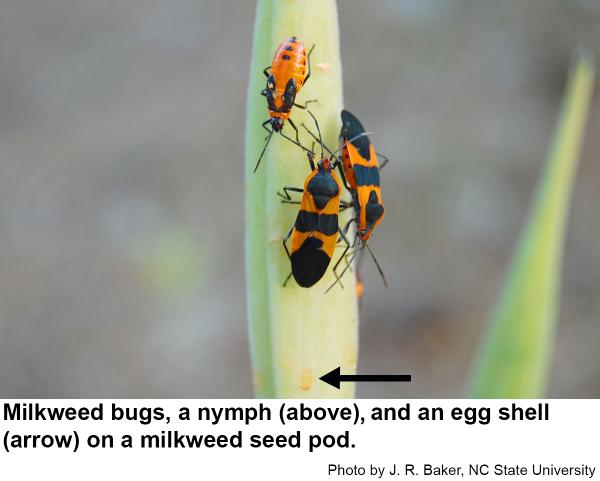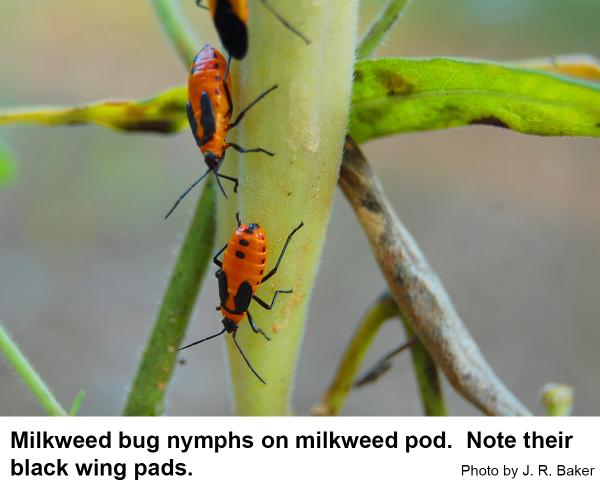Description and Biology
Milkweed bugs, Oncopeltus fasciatus, are reddish orange insects with a conspicuous black band across the middle and two large diamond-shaped black patches fore and aft. They are 1/2 to 3/4 inch long. Female milkweed bugs lay 25 to 35 eggs per day in small clusters. Eggs are light yellow but turn reddish before they hatch five days later. The nymphs emerge as tiny, elongate, red insects that soon become oval in top view. The nymphs develop and grow through five molts. Adult bugs emerge from the fifth molt. Nymphs become increasing spotted as they develop and their wing buds become more pronounced with each molt. New adults are yellow with black markings, but the yellow parts change to reddish-orange as they mature. Adults can mate a week or so after the last molt, and a week to two weeks later, females start to lay eggs. Females that have plenty of milkweed seeds available lay considerably more eggs than females on short rations. Once a new generation of adults matures, milkweed bugs migrate to sheltered spots to spend the winter, spring, and early summer. Once milkweeds develop seed pods, milkweed bugs emerge from their sheltered spots to feed and produce a new generation of bugs.
Host Plants
Milkweed seeds seem to be the only host food of the milkweed bug (although adults can be artificially maintained on cracked watermelon seeds). It has also been reported from oleander, a plant in the same plant family as milkweed.
Residential Recommendations
If the milkweeds infested with milkweed bugs are grown as food plants for monarch butterflies it may be better to live with the damage to the seeds rather than apply an insecticide. Milkweed bugs do little plant damage and are present for only a month or so. Remove leaf litter and spent stalks in the fall to eliminate overwintering sites. If the presence of the bugs is repulsive and no monarch butterfly caterpillars are present, use an insecticidal soap to kill the bugs as the dried residue of insecticidal soaps is not particularly toxic to caterpillars that might hatch shortly. If the milkweeds are not part of a butterfly garden, any of the various insecticides labeled for landscape use should give more than adequate control. Although Sevin and other insecticides have a negative impact on pollinators, milkweed bugs seem to flourish late in the growing season after milkweeds have already formed seed pods and ceased blooming.
References
- Large milkweed bug. Anonymous. 2016. Wikipedia, the free encyclopedia.
- Life History and Respiration of the Milkweed Bug Oncopeltus Fasciatus (Dallas). Niswander, R. E. 1951. The Ohio Journal of Science. 51 (1): 27-33.
- Milkweed Bugs. Anonymous. 2008. Ward's Science.
- Milkweed bugs. Anonymous. No date. Missouri Botanical Garden.
- Extension Plant Pathology Publications and Factsheets
- Horticultural Science Publications
- North Carolina Agricultural Chemicals Manual
For assistance with a specific problem, contact your local N.C. Cooperative Extension center.
This Factsheet has not been peeer reviewed.
Publication date: Nov. 27, 2013
Reviewed/Revised: Nov. 3, 2023
Recommendations for the use of agricultural chemicals are included in this publication as a convenience to the reader. The use of brand names and any mention or listing of commercial products or services in this publication does not imply endorsement by NC State University or N.C. A&T State University nor discrimination against similar products or services not mentioned. Individuals who use agricultural chemicals are responsible for ensuring that the intended use complies with current regulations and conforms to the product label. Be sure to obtain current information about usage regulations and examine a current product label before applying any chemical. For assistance, contact your local N.C. Cooperative Extension county center.
N.C. Cooperative Extension prohibits discrimination and harassment regardless of age, color, disability, family and marital status, gender identity, national origin, political beliefs, race, religion, sex (including pregnancy), sexual orientation and veteran status.



